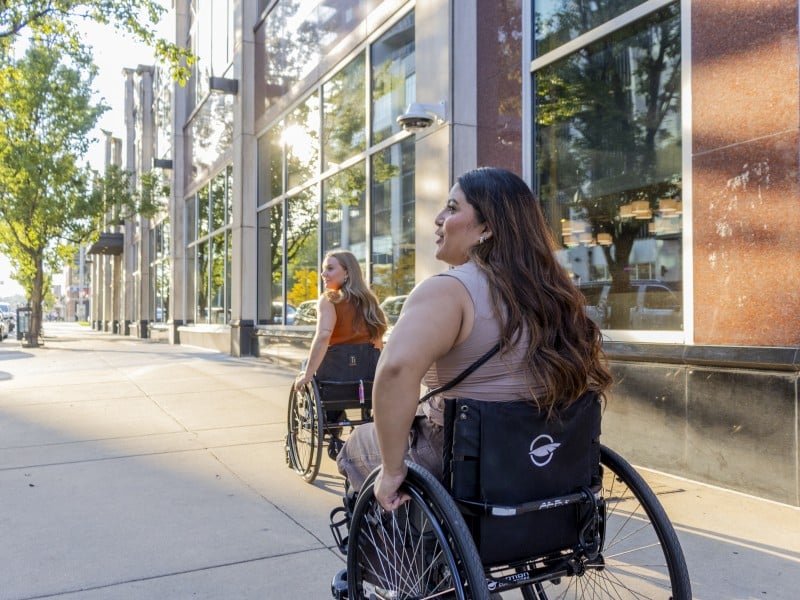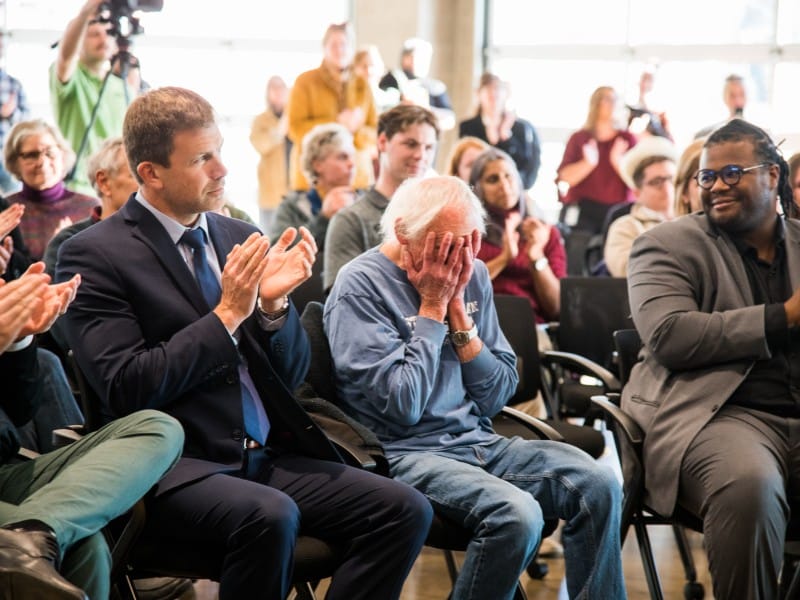You’re about to be hearing more from Calhoun County healthcare professionals on COVID-19 frontlines
Calhoun County physicians and nurses who continue to see firsthand the devastating effects of the virus on those who have it and their family members who have watched them die from it are going to be talking about it more than they have so far.
Getting your Trinity Audio player ready...
Editor’s note: This story is part of Southwest Michigan Second Wave’s On the Ground Calhoun County series.Offering up more targeted messaging and personal stories about what they are seeing in hospitals will soon become more of the norm for local healthcare professionals and healthcare systems that are on the frontlines of the COVID-19 pandemic, says Eric Pessell, Calhoun County Health Officer.
These healthcare professionals are physicians and nurses who continue to see firsthand the devastating effects of the virus on those who have it and their family members and friends who have watched them recover or die from it.
There is no official name for their efforts that will take the form of more widespread communication offering accurate information to the general public about what these health professionals are seeing, Pessell says.
With 48.6% of 126,128 residents who are eligible to be vaccinated, Calhoun County lags behind the statewide average of 58% of residents who are eligible to receive the vaccine. As Pessell and his team and organizations throughout the county, including the Battle Creek Community Foundation and the United Way of the Battle Creek Kalamazoo Region, work together on initiatives to address vaccine hesitancy, he says, “expect to hear more from the medical professionals.”

The impacts are already being felt by people who seek treatment at local hospital emergency rooms, some of whom have said they had waited anywhere from four to eight hours, depending on their medical situation.
Although it is a challenge for healthcare systems to identify an average emergency room wait time pre-COVID, a spokesperson for Bronson Healthcare Group says in a written statement that, “The current surge in COVID-19 cases definitely has an effect on the patient volume and wait times in our emergency departments. We are seeing an increasing number of unvaccinated, younger, normally healthy patients and older individuals with preexisting conditions who are needing care for COVID-19, alongside an increase of individuals seeking care for non-Covid related health issues. This strain on hospital staffing and capacity is something we are seeing not just at Bronson, but also across the region and the state.”
Last week, Pessell says he heard from one local medical director that the wait time in his Emergency Room was eight to 10 hours.
“A lot of people out there have no idea how long an emergency visit is going to be and that needs to be explained,” Pessell says. “Four to eight hours is an immensely long time and God forbid if you’re really hurt and you need immediate attention and the hospital may be transferring you someplace else because they don’t have the capacity. You hope that you don’t need emergency services because the wait time is delayed.”
The length of a wait depends on the severity of an illness or injury that brings someone into an emergency room, says Dr. William Nettleton, Assistant Professor in WMed’s Department of Family and Community Medicine and Medical Director of Kalamazoo County Health and Community Services Department and Calhoun County Public Health Department.
He says those who present with life-threatening illnesses or injuries will be taken care of ahead of those who come in with less severe symptoms that are non-life threatening.
“Emergency departments function by triage. If you’re there for a lower acuity issue, the person with the critical issue gets seen first,” Nettleton says.
For Oaklawn Hospital in Marshall, the current surge in COVID-19 hospitalizations is leading to the cancellation of elective surgeries and endoscopies.
A statement issued by Oaklawn on Monday said, “Due to the current surge in COVID-19 hospitalizations, elective surgeries and endoscopies are being canceled until further notice so that surgery staff can assist with COVID-19 and emergency patients. We appreciate your understanding as we do our very best to provide the emergency care that our community needs. If you were scheduled for an elective procedure or surgery, you can expect a phone call from your surgeon’s office to discuss further.”
“We are hearing more stories about how everyday healthcare in hospitals is being affected, whether it be emergency or specialty care,” says Dr. William Nettleton, Assistant Professor in WMed’s Department of Family and Community Medicine and Medical Director of Kalamazoo County Health and Community Services Department and Calhoun County Public Health Department.
Nettleton says hospitals throughout Michigan are dealing with a surge in COVID-19 cases and hospitalizations and staff at those hospitals are feeling overwhelmed and fatigued.
“At this time, it will be helpful to hear and see what is actually happening in healthcare systems and to connect how COVID rates and healthcare staffing are being impacted by burnout and shortages that affect delivery of healthcare,” Nettleton says. “Even if their patients don’t have COVID-19, it’s important for doctors and nurses to tell their stories and talk about what they’re experiencing.”
He says people who work in hospitals, public health and healthcare are being impacted by the moral injury that has been inflicted on them. He defines moral injury as a situation in which “someone experiences suffering that’s preventable over and over again. And people are also angry at us at the same time and that just adds to it.”
Pessell has been dealing with his own sense of moral injury which increases as the number of unvaccinated Calhoun County residents remains unchanged while the number of COVID-related cases and death increase.
A different messenger, a more receptive audience
“We are in the midst of the worst transmission rates we have seen so far,” Pessell says.
On Nov. 24, he says there were 22 recorded deaths from COVID for the month.
“That’s almost one death per day. In the last 24 hours we have had 180 new confirmed cases of COVID and 63 of those are minors under the age of 18. Coming out of Thanksgiving it doesn’t look good,” Pessell says. “We have 70 people with COVID in our two hospitals today.”
As of Tuesday, there were 372 new confirmed cases of COVID in Calhoun County. On Nov. 24, Pessell says there were 177 confirmed cases of COVID. That broke a record on Nov. 19 of 161 cases which broke last November’s record of 140 cases.
“We’ve broken a lot of records that aren’t records we want to break anymore,” he says. “We’re at a point where we need the White Coats to come out and talk to people. We’re at a crisis point now and the question is who’s the messenger and what’s the message. The reality is that Public Health cannot no longer be the sole messenger because of things that have happened over time.”
The “things” he cites range from the general public’s knowledge about what departments like his are and what they do, to a lack of understanding about the rapidly changing information that is disseminated about the virus.
“The knowledge we’re collecting from the virus is going to change over time. It doesn’t make what we said today or last week or last month wrong, it’s just changing,” Pessell says. “What I say to you today is true today and tomorrow that may change and this is how it works with a virus we’d never seen before that is attacking us in so many different ways.”
Pessell says people don’t understand that the complex nature of the virus and its variants are a moving target that can’t be easily explained away in a sound bite. He says leadership at the Centers for Disease Control and at the White House need to share information that offers more in-depth explanations about why they’re asking people to wear masks, social distance, and get vaccinated.
“We’ve all watched videos of Dr. Fauci saying nobody needs to be wearing a mask and the next month, he said everybody should be,” Pessell says. “The problem is (people become skeptical) when you change the message and you aren’t discussing the nuance of what is changing and we don’t go into that.”
This pivoting, while understandable to those who deal with the intricacies of the pandemic on a daily basis, has created confusion and distrust that has led to an unwillingness to take the virus seriously and get vaccinated.
“People are tired. They’ve been hearing about COVID for almost two years. They’ve heard the recommendations about being masked, social distancing, and getting tested,” Nettleton says. “But, there’s still so much misinformation out there. This health misinformation is a public health crisis that’s harming the health of individuals, communities and families.”
No matter how much information he shares or how often he talks about ways to prevent the spread of the virus or the importance of being vaccinated, Pessell says he continues to get questions and pushback. He says he sometimes feels like he’s in an echo chamber where no one is listening.
“I’m still getting organizations that are contacting me to see what my recommendation is for the upcoming holiday season in terms of masks and social distancing,” Pessell says.
His number one recommendation remains – get vaccinated.
“That message has been out there and I hear people argue about it on social media and I get nasty emails from folks saying that it’s nothing more than the flu,” Pessell says. “In Calhoun County in an 18-month period we have not lost 358 people to the flu, but we have lost that many to COVID.”
These local COVID victims are part of a group of more than 700,000 throughout the United States who have succumbed to the virus.
“I don’t know why we as a country don’t look at 700,000 deaths as a major health crisis,” Pessell says.
Since the start of the pandemic, Pessell and his team of about 75 have been the local “go to” source of information and updates on COVID-19 and emerging variants of the virus that in many cases changes hourly and daily based on what they are hearing from state and federal health officials. In addition, they have orchestrated numerous vaccine clinics, both static and drive-thru at locations across the county.
“We also have a team of Public Health nurses who are part of our Communicable Disease program who are doing case investigations and tracing and our staff supports them,” he says. “They are following up on every case involving a minor under the age of 18. Right now they’re averaging 60 minor cases per day.”
This laser-focused approach comes on top of the regular services provided by the county’s public health department which includes family planning, testing for HIV and other sexually transmitted diseases, and lead testing.
“In local public health they’ve been doing COVID response on top of their own duties and they have less resources overall,” Nettleton says. “These are people who continue to do this amazing work, who make it happen and who continue to make an impact.”
But, Pessell says, “If people were going to listen to Public Health officials about COVID and the importance of getting vaccinated, they would have done it by now. We still have the same tools in our toolbox and those haven’t changed. What has changed is the politicization around COVID and the vaccines which took the focus away from it as a health issue. Our healthcare system is once again in crisis and COVID is affecting all of us in ways we haven’t seen before and that message needs to be delivered by those who are on the frontlines and experiencing it in ways that are different from the rest of us.”
















